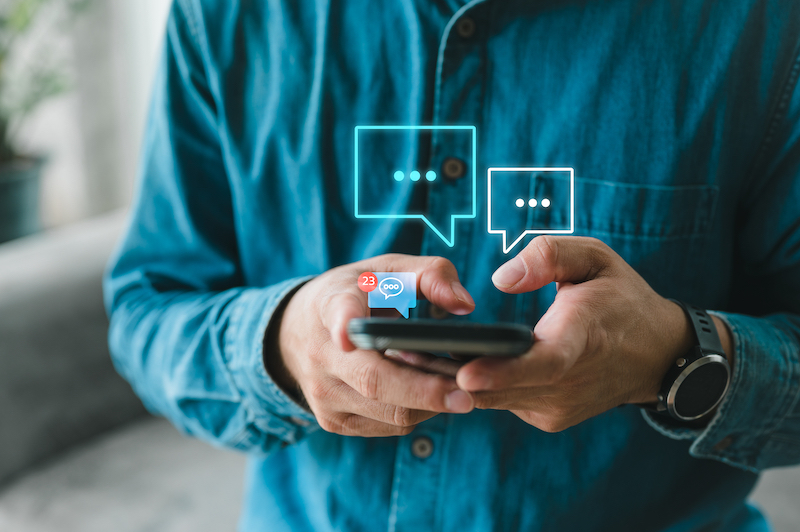Leveraging AI Chatbots as Part of Your Digital Marketing Strategy

Staying competitive these days requires more than just an online presence. It demands a strategic approach that incorporates cutting-edge technologies to enhance customer engagement and their experience. This is why in this comprehensive blog post we will explore the significance of AI chatbots as part of your digital marketing strategy; diving into why they matter and how to implement them effectively to drive results.
So What Are Chatbots?
Chatbots are artificial intelligence (AI) programs that have designed to simulate human conversation- this is possible as they can interact with users in natural language through various messaging platforms, websites, or mobile apps. Chatbots can be rule-based, following pre-defined scripts, or powered by machine learning algorithms that enable them to learn and improve their responses over time.
The Rise of Chatbots in Digital Marketing
The rise of chatbots can be attributed to several factors:
1- 24/7 Availability: Chatbots are available round the clock, providing instant responses to customer queries and enhancing user experiences.
2- Cost-Efficiency: They reduce the need for human customer support agents, saving businesses time and money while maintaining quality service.
3- Scalability: Chatbots can handle numerous conversations simultaneously, making them scalable for businesses of all sizes.
4- Data Collection: They can gather valuable customer data, which can be used for personalization and improving marketing strategies.
The Significance of Chatbots in Digital Marketing
1- Enhanced Customer Engagement
Chatbots provide instant responses to customer inquiries. This ensures that potential leads don’t slip through the cracks due to delayed responses and fosters a positive customer experience and encourages user interactions.
2- Personalization at Scale
Chatbots can collect user data such as preferences and past interactions. This offers personalized product recommendations and content and even though this level of personalization is difficult to achieve manually, it is crucial for effective marketing.
3- Lead Generation and Qualification
Chatbots can initiate conversations with website visitors and qualify leads based on their responses. They can ask qualifying questions and direct high-potential leads to human sales representatives, optimizing the lead generation process.
4- Improved Customer Support
Chatbots can handle common customer support inquiries, providing immediate solutions to frequently asked questions. Incorporating them as part of your website’s technical development helps to improve your brand’s customer satisfaction and frees up human support agents to focus on more complex issues.
5- Streamlined Sales Funnel
By guiding users through the sales funnel, chatbots can actually help and assist in product selection, answer questions, and even facilitate the purchase process. This streamlined approach can boost conversion rates and revenue.
6- Data Analytics and Insights
Chatbots are able to collect valuable user data that can be analyzed to gain insights into customer behavior- these insights can inform marketing strategies and product development.
7- Cost Savings
Reducing the workload of human agents and automating repetitive tasks can lead to significant cost savings for businesses; chatbots offer a cost-effective way to handle routine inquiries.
How to Implement Chatbots in Your Digital Marketing Strategy

1- Define Your Objectives
Begin by identifying your goals for integrating chatbots into your digital marketing strategy. Your common objectives can include- improving customer engagement, increasing lead generation, providing better customer support, and boosting sales.
2- Choose the Right Platform
Select the platform(s) where you want to deploy your chatbot. This could include your website, social media channels, messaging apps like Facebook Messenger, or a dedicated chat window on your mobile app.
3- Determine Chatbot Capabilities
Decide what tasks and interactions your chatbot will handle. Will it be primarily for customer support, lead generation, or a combination of functions? Define its scope and capabilities accordingly.
4- Design a Conversation Flow
Create a conversation flowchart that outlines how the chatbot will interact with users. This includes the greeting, responses to common questions, escalation to human agents when necessary, and the handling of various scenarios.
5- Develop or Choose a Chatbot
Depending on your technical expertise and resources, you can either develop a chatbot in-house or use a chatbot-building platform. There are many user-friendly chatbot development tools available that require no coding skills.
6- Train Your Chatbot
If your chatbot relies on machine learning, train it using historical data or real-time interactions. Ensure it understands user intent and provides accurate responses.
7- Test Thoroughly
Before deploying your chatbot, conduct extensive testing to identify and rectify any issues. Test different user scenarios and ensure the chatbot functions smoothly.
8- Deploy and Monitor
Once your chatbot is ready, deploy it on the selected platforms. Continuously monitor its performance and gather feedback to make necessary improvements.
9- Maintain and Update
Regularly update your chatbot to keep up with changing user needs and technology advancements. Stale or outdated chatbots can frustrate users and harm your reputation.
Success Stories: Brands Embracing Chatbots
1- Sephora
Sephora, a global cosmetics retailer, introduced a chatbot on the messaging platform Kik to engage with younger customers. The chatbot offers makeup tips, product recommendations, and allows users to book in-store appointments. The result? Increased customer engagement, higher sales, and valuable data on customer preferences.
Domino’s Pizza implemented a chatbot for ordering pizzas via various messaging apps. Customers can place orders, track deliveries, and even customize their pizzas through the chatbot. This innovation streamlined the ordering process, leading to a significant boost in sales.
3- Mastercard
Mastercard launched a chatbot on Facebook Messenger to help cardholders find local deals and offers- the chatbot uses location data and user preferences to provide personalized discounts. This initiative added value to cardholders and reinforced Mastercard’s brand as a provider of tailored financial solutions.
In conclusion, it is important to work on incorporating chatbots into your digital marketing strategy- with them you can enhance customer engagement, generate and qualify leads, provide efficient customer support, and gain valuable insights into user behavior. You may also contact one of our experts at Internet Marketing Geeks so we can help with your overall digital marketing strategy– and help incorporate your chatbot with it!

